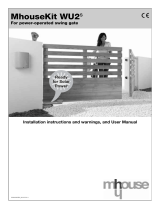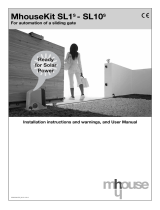These are the most important phases of automation set-up for ensuring maxi-
mum system safety. The test can also be performed as a periodic check of
automation devices. Testing and commissioning of the automation must be
performed by skilled and qualified personnel, who are responsible for the tests
required to verify the solutions adopted according to the risks present, and for
ensuring observance of all legal provisions, standards and regulations, and in
particular all requirements of the standard EN 12445, which establishes the test
methods for checking automations for doors and gates. The additional devices
must undergo a specific test for functionality and correct interaction with
MC824H. Refer to the instruction manuals of the individual devices.
4.1 - Testing
The sequence of operations to be performed for testing and described below
refers to a typical system (fig. 2):
1 Ensure that everything stated in the “Installation warnings” chapter has
been observed.
2 Release the gearmotors for manual operation as described in the relevant
instruction manual. Pushing at the prescribed point for manual operation,
check that it is possible to open and close the leafs with a force lower than
390 N.
3 Lock the gearmotors (see relevant instruction manual).
4 Using the control devices (transmitter, key-operated selector switch or con-
trol pushbuttons, etc.), perform tests of opening, closing and stopping the
gate, and ensure that leaf movement corresponds to specifications. Test
several times to check for leaf movement and any defects in assembly or
adjustment and any possible points of friction.
5 Check operation of all system safety devices one at a time (photocells, sen-
sitive edges, etc.). Each time a device is activated the “BLUEBUS” LED on
the control unit must flash rapidly twice to confirm acknowledgement of the
event.
6 If hazardous situations generated by the moving leafs are protected by
means of impact force limitation, measure the force as specified in the stan-
TESTING AND COMMISSIONING
4
4 – English
EN
03. Press or keys within 10 seconds to go to the LED corresponding to
the type of gearmotor connected to the control unit (see Table 3);
04. Press and hold down
the “Set” key for at least 3 seconds to memorize the
selected gearmotor. After 3 sec. LED L1 starts flashing, then release the key;
05. Press and hold
keys “Set” and “” at the same time.
06. Release the keys when leds “L3” and “L4” start flashing quickly (after
approx. 3 seconds).
07. Ensure that the automation completes the following sequences of ma -
noeuvres:
a - Low speed closure of gearmotor M1 through to the mechanical stop
b - Low speed closure of gearmotor M2 through to the mechanical stop
c - low speed opening of gearmotor M2 and gearmotor M1 through to the
mechanical stop
d - High speed closure of gearmotors M1 and M2
Warnings:
– If the first manoeuvre (a) does not close the leaf controlled by motor M1 but
closes the one controlled by M2, press key “
” or “
” to stop the learning
phase. At this point, invert the connections of motors M1 and M2 on the ter-
minals on the control unit and then those of the respective encoders; after
this start the procedure from point 05;
– If the first two manoeuvres (a e b) are not “closing” but are “opening”, press
key “
” or “
” to stop the learning phase. At this point, on the gearmotor
that completed the opening manoeuvre, invert the polarity of the two wires of
gearmotor M1 (terminals 7 and 9 for M1; terminals 10 and 12 for M2) and
then start the procedure from point 05;
08. At the end of the Closing manoeuvre of the 2 motors (d), leds “L3” and “L4”
turn off to indicate the that the procedure has been completed correctly.
Warnings:
– During the automatic learning procedure, if a photocell trips or a device con-
nected to the “stop” input is activated, the procedure is interrupted and led
L1 starts flashing. To resume the learning process, the procedure must be
started again from point 05;
– The automatic learning procedure can be repeated at any time, also after
installation; for example following modifications to the position of the
mechanical stops.
3.7.2 - Learning in manual mode
Caution! – From step 05 onwards:
– to move from led L1 to L8
, briefly press key or (the led flashes to indi-
cate the current position);
– to move the motor
in one or the other direction, press and hold key or .
01. Press and hold down
“Set” and keys at the same time;
02. Release the keys when LED L1 begins to flash (motor selection: not per-
formed) or when any of the LEDs L1 ... L8 lights up (motor selection:
already performed);
03. Press or keys within 10 seconds to go to the LED corresponding to
the type of gearmotor connected to the control unit (see Table 3);
04. Press and hold down
the “Set” key for at least 3 seconds to memorize the
se lected gearmotor. After 3 sec. LED L1 starts flashing, then release the key;
05. LED
L1 flashes: position 0 of M1
To bring motor 1 to position 0 (fig. B): press and hold down
the or
keys. On reaching the position, release the key to stop the manoeuvre. To
memorise the position, press and hold down
the “Set” key for at least 3
seconds and then release it (after 2 seconds LED L1 remains on and on
releasing the “Set” key LED L2 begins flashing).
• LED
L2 flashes: position 0 of M2
To bring motor 2 to position 0 (fig. B): press and hold down the or
keys. On reaching the position, release the key to stop the manoeuvre. To
memorise the position, press and hold down the “Set” key for at least 3
seconds and then release it (after 2 seconds LED L2 remains on and on
releasing the “Set” key LED L3 begins flashing).
• LED
L3 flashes: position SA of M2
To bring motor 2 to position SA (fig. B): press and hold down the or
keys. On reaching the position, release the key to stop the manoeuvre. To
memorise the position, press and hold down the “Set” key for at least 3
seconds and then release it (after 2 seconds LED L3 remains on and on
releasing the “Set” key LED L4 begins flashing).
• LED
L4 flashes: position A of M1
To bring motor 1 to position A (fig. B): press and hold down the or
keys. On reaching the position, release the key to stop the manoeuvre. To
memorise the position, press and hold down the “Set” key for at least 3
seconds and then release it (after 2 seconds LED L4 remains on and on
releasing the “Set” key LED L5 begins flashing).
• LED
L5 flashes: position A of M2
To bring motor 2 to position A (fig. B): press and hold down the or
keys. On reaching the position, release the key to stop the manoeuvre. To
memorise the position, press and hold down the “Set” key for at least 3
seconds and then release it (after 2 seconds LED L5 remains on and on
releasing the “Set” key LED L6 begins flashing).
• LED
L6 flashes: position SC of M1
To bring motor 1 to position SA (fig. B): press and hold down the or
keys. On reaching the position, release the key to stop the manoeuvre. To
memorise the position, press and hold down the “Set” key for at least 3
seconds and then release it (after 2 seconds LED L6 remains on and on
releasing the “Set” key LED L7 begins flashing).
• LED
L7 flashes: position 1 of M1
To bring motor 1 to position 1 (fig. B): press and hold down the or
keys. On reaching the position, release the key to stop the manoeuvre. To
memorise the position, press and hold down the “Set” key for at least 3
seconds and then release it (after 2 seconds LED L7 remains on and on
releasing the “Set” key LED L8 begins flashing).
• LED
L8 flashes: position 1 of M2
To bring motor 2 to position 1 (fig. B): press and hold down the or
keys. On reaching the position, release the key to stop the manoeuvre. To
memorise the position, press and hold down the “Set” key for at least 3
seconds and then release it to exit programming (after 2 seconds LED L8
remains on until the “Set” key is released).
Note – Manual programming in a system with a single gearmotor: pro-
ceed as described at the beginning of this paragraph from step 01. At step 05
proceed as follows:
- Program the positions related to led L1 (0 of M1) and L7 (1 of M1) as
follows: press and hold the “Set” key for at least 3 seconds and then release
(after 2 seconds the LED remains on, and on release of the “Set” key the next
LED begins flashing).
- Do not program
the positions related to led L3 (SA of M2) - L4 (A of
M1) - L6 (SC of M1): briefly press key or to move between positions.
3.7.3 - Learning in combined mode
Perform this procedure after completing the automatic learning cycle:
01. Press and hold
keys “Set” and “” at the same time.
02. Release the key when led L1 starts to flash (selection of motors: never
performed) or when any one of leds L1 to L8 lights up (selection of
motors: already performed);
03. Within 10 seconds, press key “” or “” to move the Led corresponding
to the type of gearmotor connected to the control unit (see Table 3);
04. Press and hold the key “Set” for at least 3 seconds, to memorise the
selected gearmotor. After the 3-second interval, led “L1” starts flashing; at
this point release the key;
05. Briefly press key “” or “” to move the flashing led (L1-L8) to the position
to be programmed and proceed for each position, as described in step 05
of the manual learning procedure (paragraph 3.7.2).
Repeat this operation for all other positions to be modified.
To complete the manual learning process, press key “” repeatedly to move
the led that flashing beyond position L8.
3.8 - Checking movement of gate leafs
At the end of the learning procedure, it is advisable to make the control unit per-
form a few opening and closing manoeuvres to ensure that the gate moves cor-
rectly and to check for installation or setting defects.
01. Press “Open”. Verify correct offset of the leafs on opening and ensure that
the opening manoeuvre comprises the acceleration phase, the constant
speed phase and the deceleration phase. At the end of the manoeuvre,
the leafs must stop a few centimetres from the opening mechanical stop.
02. Press the “Close” key and check that the closure manoeuvre includes the
acceleration, constant speed and deceleration phases. Check that the leaf
closure offset is correct. At the end of the manoeuvre, the leafs must be
perfectly closed on the mechanical closure stop.
03. Make sure that the flashing light flashes at intervals of 0.5 sec on, 0.5 sec
off during manoeuvres.


















